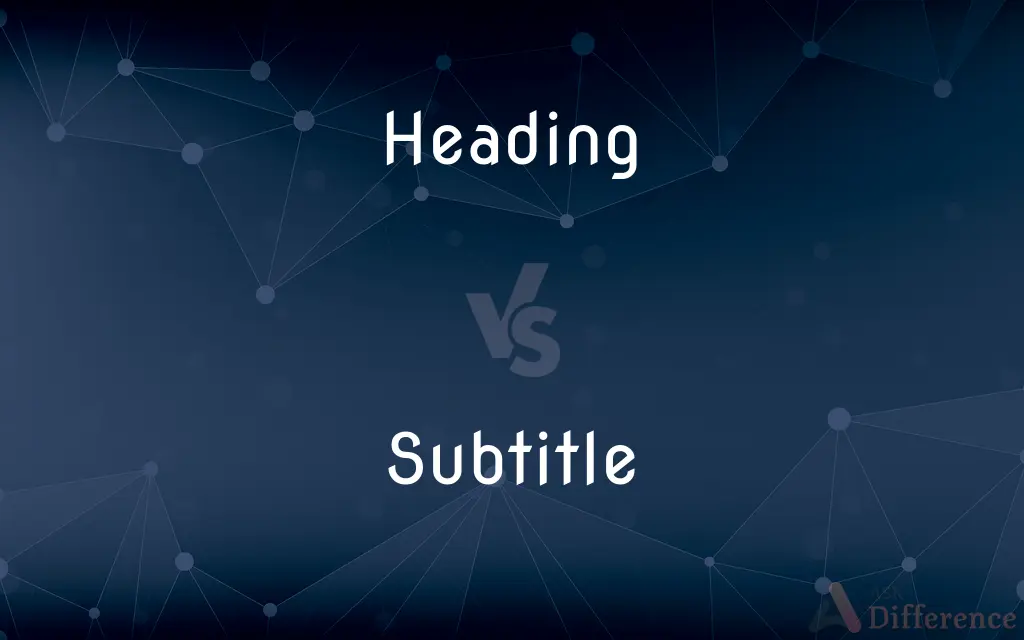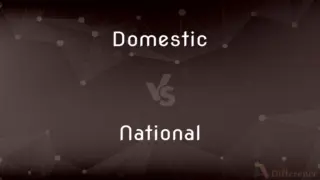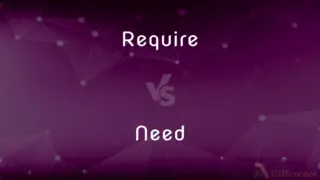Heading vs. Subtitle — What's the Difference?
By Maham Liaqat & Urooj Arif — Updated on March 10, 2024
Headings are titles that introduce or summarize the content below them, while subtitles provide additional information or context to the heading.

Difference Between Heading and Subtitle
Table of Contents
ADVERTISEMENT
Key Differences
Headings serve as the primary titles for sections, articles, or pages, clearly indicating the topic or main idea. They are crucial for navigation and understanding the structure of a document or website, guiding the reader through the content. Subtitles, on the other hand, are secondary titles that complement headings by offering extra detail, clarifying the content, or providing a teaser of the information to come, enriching the reader's comprehension without the need for immediate engagement with the full text.
While headings are often designed to be concise and direct, catching the reader's attention and conveying the essence of the following content, subtitles can afford to be more descriptive or creative. They work to build interest or provide a brief insight into the tone or direction of the content, setting expectations for the reader. This difference highlights how each element plays a distinct role in the presentation and organization of information.
In terms of hierarchy, headings usually command a higher level of importance within a document's structure, often formatted with larger or bolder fonts to stand out. Subtitles, while still significant, are typically presented in a smaller or less prominent style, visually signaling their supportive role to the main heading. This visual distinction helps readers differentiate between the main topics and supplementary information at a glance.
The use of headings and subtitles also varies in academic writing, journalism, and online content creation. In academic contexts, headings and subtitles are used to organize complex information into digestible sections, making it easier for readers to follow arguments or research findings. In journalism and online content, they serve to grab attention and break down stories or articles into manageable parts, enhancing readability and engagement.
In digital content, headings and subtitles play a crucial role in search engine optimization (SEO). Headings, particularly, are key to helping search engines understand the content's structure and relevance to search queries, whereas subtitles can add context and depth, potentially improving the content's search ranking by including additional keywords and phrases.
ADVERTISEMENT
Comparison Chart
Purpose
Introduces or summarizes content
Provides additional information or context
Hierarchy
Higher level of importance
Secondary, supports the heading
Design
Larger, bolder fonts
Smaller, less prominent style
Function
Guides through content structure
Enriches comprehension with details
Use in SEO
Helps with content structure understanding
Adds context and depth
Compare with Definitions
Heading
Formatted prominently for visibility.
The document used bold for its main headings.
Subtitle
Secondary title providing additional context.
The subtitle clarified the scope of the study.
Heading
Primary title introducing content.
The chapter's heading was The Rise of Civilizations.
Subtitle
Can be descriptive or creative.
Subtitles often contain a witty remark or a clarifying detail.
Heading
Guides the reader through document structure.
Each section had a clear heading for easy navigation.
Subtitle
Enhances reader engagement and understanding.
A well-chosen subtitle can make content more inviting.
Heading
Key to content organization and SEO.
Proper headings improve a website's search engine ranking.
Subtitle
Supports the heading with more detail.
The article's subtitle hinted at unexpected findings.
Heading
Designed to catch attention.
Catchy headings are essential for engaging readers.
Subtitle
Less prominently formatted than headings.
Subtitles were italicized to differentiate them from headings.
Heading
A title at the head of a page or section of a book
Chapter headings
Subtitle
Captions displayed at the bottom of a cinema or television screen that translate or transcribe the dialogue or narrative
Films in foreign languages with English subtitles
Heading
A direction or bearing
He crawled on a heading of 90 degrees until he came to the track
Subtitle
A subordinate title of a published work or article giving additional information about its content
The book had now acquired its final title with a qualifying subtitle
Heading
A horizontal passage made in preparation for building a tunnel.
Subtitle
Provide (a film or programme) with subtitles
Much of the film is subtitled
Heading
A strip of cloth at the top of a curtain above the hooks or wire by which it is suspended.
Subtitle
Provide (a published work or article) with a subtitle
The novel was aptly subtitled
Heading
The title, subtitle, or topic that stands at the top or beginning, as of a paragraph, letter, or chapter.
Subtitle
A secondary, usually explanatory title, as of a literary work.
Heading
The course or direction in which a ship or aircraft is pointing or moving.
Subtitle
A printed translation of foreign-language dialogue shown at the bottom of the screen, as in a film or a television broadcast.
Heading
A gallery or drift in a mine.
Subtitle
To give a subtitle to.
Heading
The end of a gallery or drift.
Subtitle
To provide with subtitles
A film that was subtitled for English-speaking audiences.
Heading
Present participle of head
Subtitle
(authorship) A heading below or after a title.
Heading
The title or topic of a document, article, chapter, or of a section thereof.
Put the information under the "Advantages" heading
Subtitle
Textual versions of the dialogue in films (and similar media such as television or video games), usually displayed at the bottom of the screen.
Heading
(nautical) The direction into which a seagoing or airborne vessel's bow is pointing (apparent heading) and/or the direction into which it is actually moving relative to the ground (true heading)
Subtitle
To create subtitles for the dialogue in a film.
Heading
Material for the heads of casks, barrels, etc.
Subtitle
Translation of foreign dialogue of a movie or TV program; usually displayed at the bottom of the screen
Heading
(mining) A gallery, drift, or adit in a mine; also, the end of a drift or gallery; the vein above a drift.
Subtitle
Secondary or explanatory title
Heading
(sewing) The extension of a line ruffling above the line of stitch.
Subtitle
Supply (a movie) with subtitles
Heading
(masonry) The end of a stone or brick which is presented outward.
Heading
(flags) A strip of material at the hoist end of a flag, used for attaching the flag to its halyard.
Heading
The act or state of one who, or that which, heads; formation of a head.
Heading
That which stands at the head; title; as, the heading of a paper.
Heading
Material for the heads of casks, barrels, etc.
Heading
A gallery, drift, or adit in a mine; the vein above a drift.
Heading
The extension of a line ruffling above the line of stitch.
Heading
That end of a stone or brick which is presented outward.
Heading
A line of text serving to indicate what the passage below it is about;
The heading seemed to have little to do with the text
Heading
The direction or path along which something moves or along which it lies
Heading
A horizontal (or nearly horizontal) passageway in a mine;
They dug a drift parallel with the vein
Common Curiosities
Can a document have both headings and subtitles?
Yes, many documents, articles, and books use both headings and subtitles for better organization and clarity.
What is a subtitle?
A subtitle is a secondary title that provides additional information or context to the heading, enriching the reader's understanding.
How are headings and subtitles formatted differently?
Headings are usually formatted with larger or bolder fonts to stand out, whereas subtitles are presented in a smaller or less prominent style.
What is a heading?
A heading is a title at the top of a page, section, or article that introduces or summarizes the content below it.
How do headings aid in content navigation?
Headings serve as markers throughout a document, helping readers easily locate and navigate to specific sections or topics.
Is it possible to have multiple subtitles under a single heading?
Yes, depending on the content structure, multiple subtitles can be used under a single heading to further break down information.
How do headings and subtitles differ in purpose?
Headings aim to introduce or summarize content, while subtitles provide extra detail or context to the heading.
Can subtitles contain keywords for SEO?
Yes, subtitles can include additional keywords and phrases, adding depth to content and potentially improving SEO.
Are headings necessary for all types of documents?
While not mandatory, headings are highly beneficial for organizing and structuring all types of documents, from academic papers to web content.
How should headings be chosen?
Headings should be clear, concise, and reflective of the content they introduce or summarize.
How do headings and subtitles contribute to the overall readability of a document?
Together, they structure the content into digestible sections, guide the reader through the document, and enhance comprehension and engagement.
Why are headings important in digital content?
Headings help structure content for both readers and search engines, improving navigation and potentially enhancing SEO.
How do subtitles enhance reader engagement?
Subtitles can provide clarifying details or enticing teasers, making the content more inviting and understandable.
Do subtitles always follow a heading?
Typically, yes, subtitles follow a heading to provide additional information, though some creative formats may vary.
Can headings and subtitles be of the same size?
Generally, headings are larger or bolder than subtitles to indicate their greater importance and hierarchical position.
Share Your Discovery

Previous Comparison
Domestic vs. National
Next Comparison
Require vs. NeedAuthor Spotlight
Written by
Maham LiaqatCo-written by
Urooj ArifUrooj is a skilled content writer at Ask Difference, known for her exceptional ability to simplify complex topics into engaging and informative content. With a passion for research and a flair for clear, concise writing, she consistently delivers articles that resonate with our diverse audience.














































